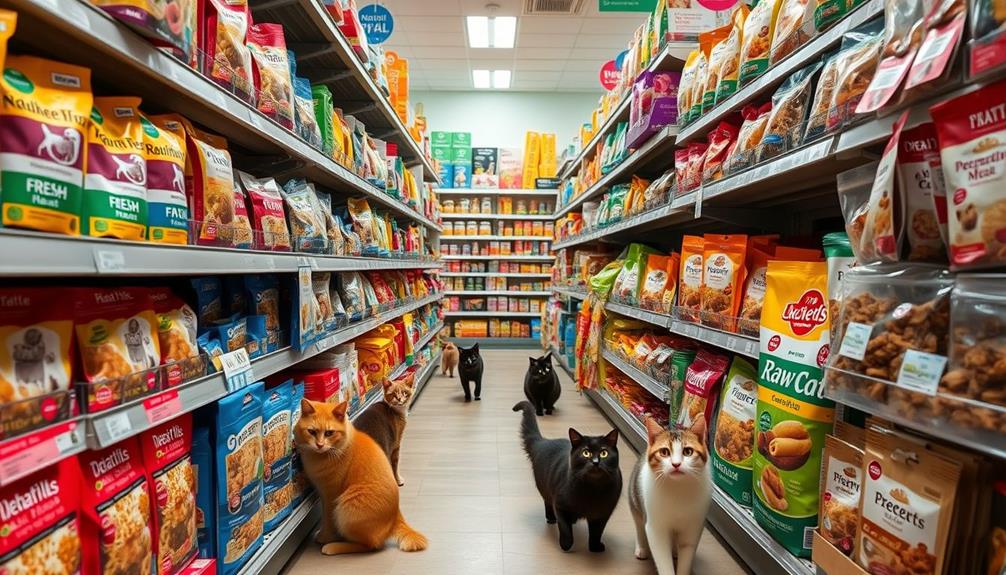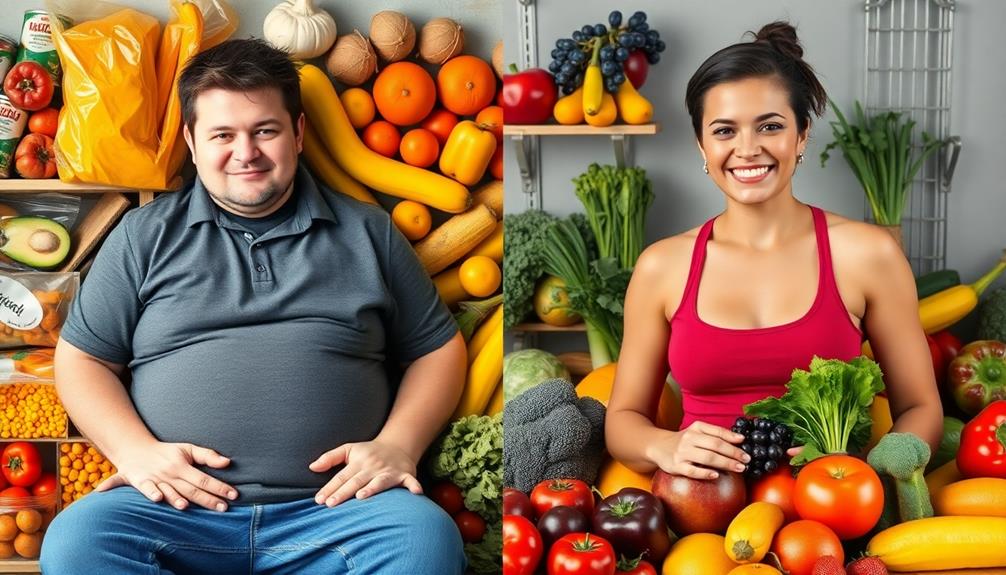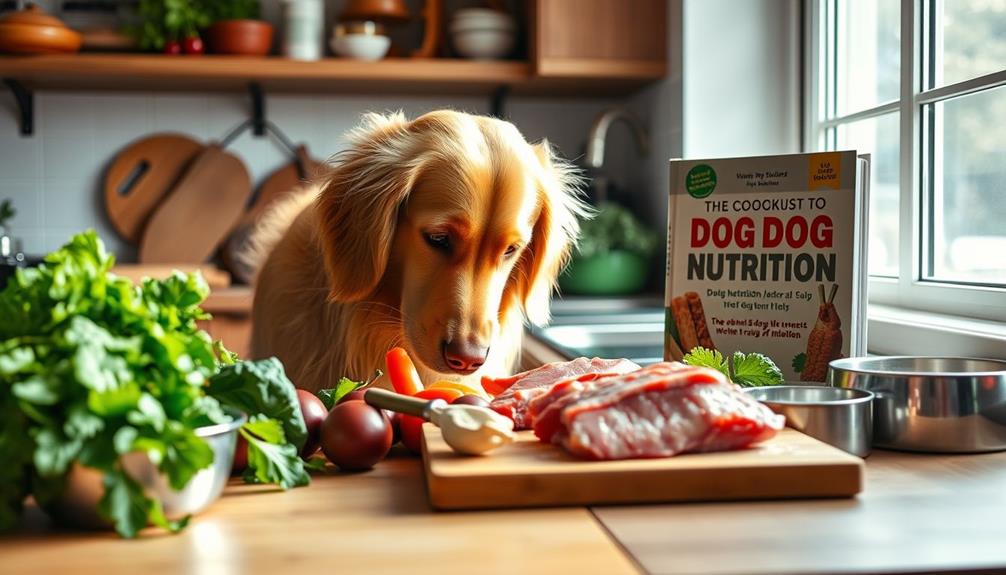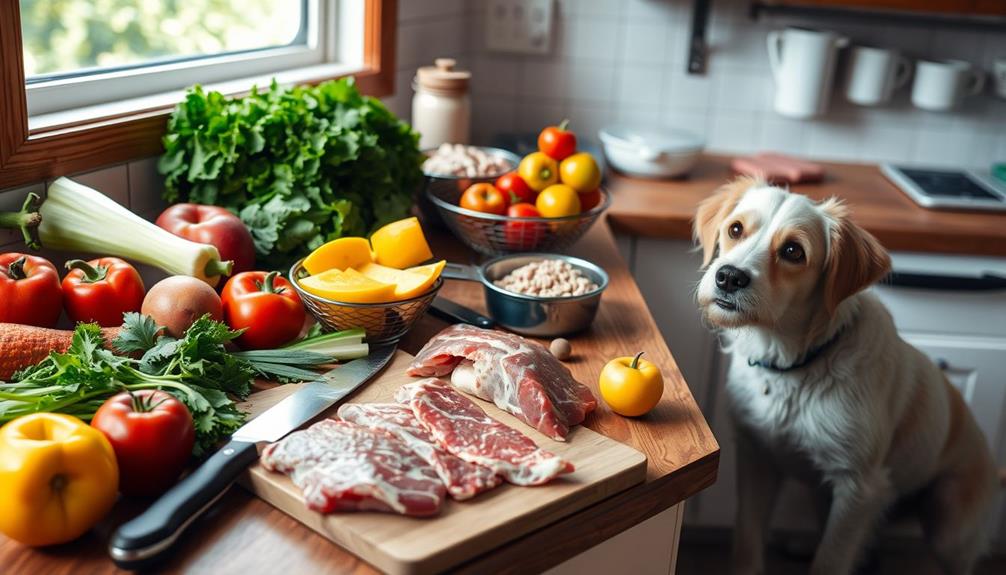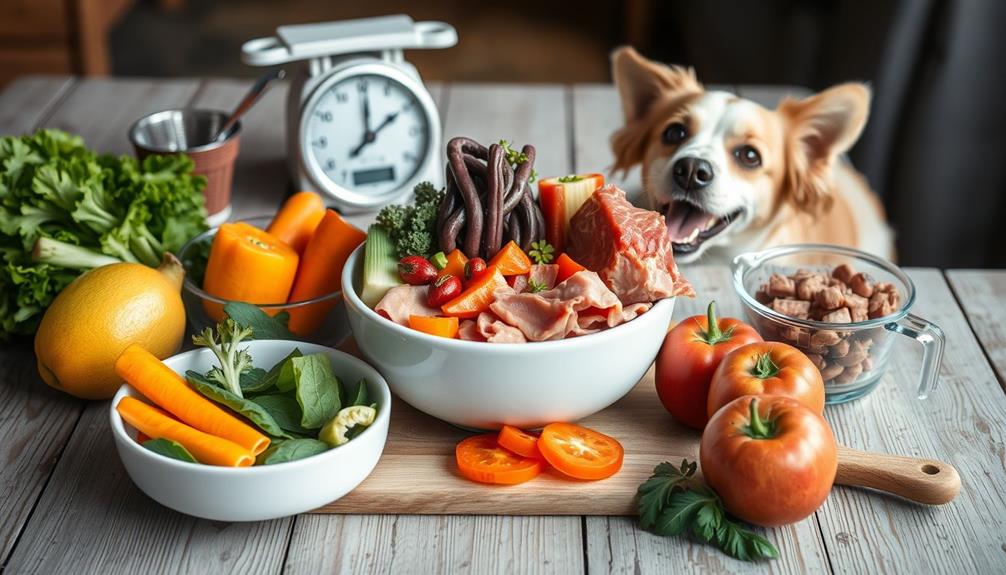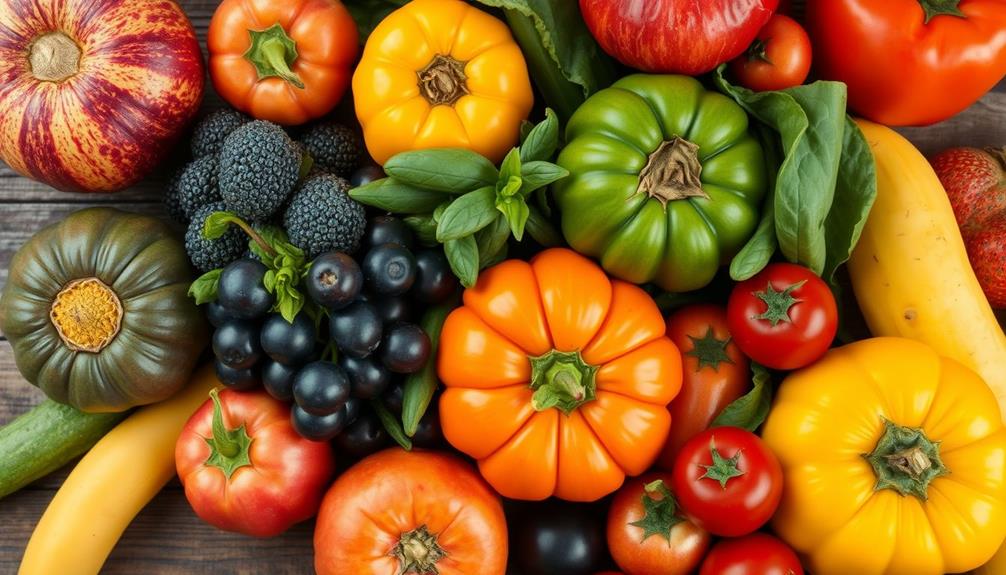You can find high-quality raw food for your cat at several top places. Pet specialty stores offer a wide selection of options and knowledgeable staff to help you choose. Online retailers give you access to various brands and even subscription services for easy ordering. You might also consider local farmers' markets for fresh, sustainably sourced ingredients. Veterinary clinics often carry specialized brands and can recommend foods tailored to your cat's specific health needs. If you're looking for the best deals, bulk purchasing can save you money. There's plenty more to explore in your quest for the perfect raw food!
Key Takeaways
- Pet specialty stores offer a wide selection of raw cat food with expert guidance on choosing the right options for your pet's needs.
- Online retailers provide extensive selections and convenient delivery options, including subscriptions for consistent supplies of raw food.
- Local farmers' markets ensure fresh, high-quality ingredients while supporting local producers and sustainable practices.
- Veterinary clinics offer specialized raw food brands and professional recommendations tailored to your cat's health requirements.
- Subscription services deliver raw food directly to your door, with flexible plans and discounts for regular orders.
Pet Specialty Stores
Shopping at pet specialty stores can be a convenient way to find raw food for your cat. Stores like Petco offer a wide selection of raw cat food options, featuring various protein sources such as chicken, turkey, and rabbit.
You'll appreciate the variety available, allowing you to choose what best suits your feline friend's taste and dietary needs. Additionally, it's important to take into account proper diet considerations when selecting raw food for your cat, ensuring that it meets their nutritional requirements.
One great option is freeze-dried raw food, which has a longer shelf life. This means you can stock up without worrying about spoilage, making your life a bit easier.
Many stores offer in-store pickup for brands like Freshpet, so you can quickly grab fresh and frozen cat food without the hassle of waiting for delivery.
Additionally, the staff at pet specialty stores are usually knowledgeable about raw cat food. They can provide valuable insights to help you select the best options tailored to your cat's specific requirements.
Plus, if you're looking to save some money, you'll often find bulk buying options, especially for frozen foods, making it easier to keep your kitty well-fed with their preferred raw meals.
Online Retailers
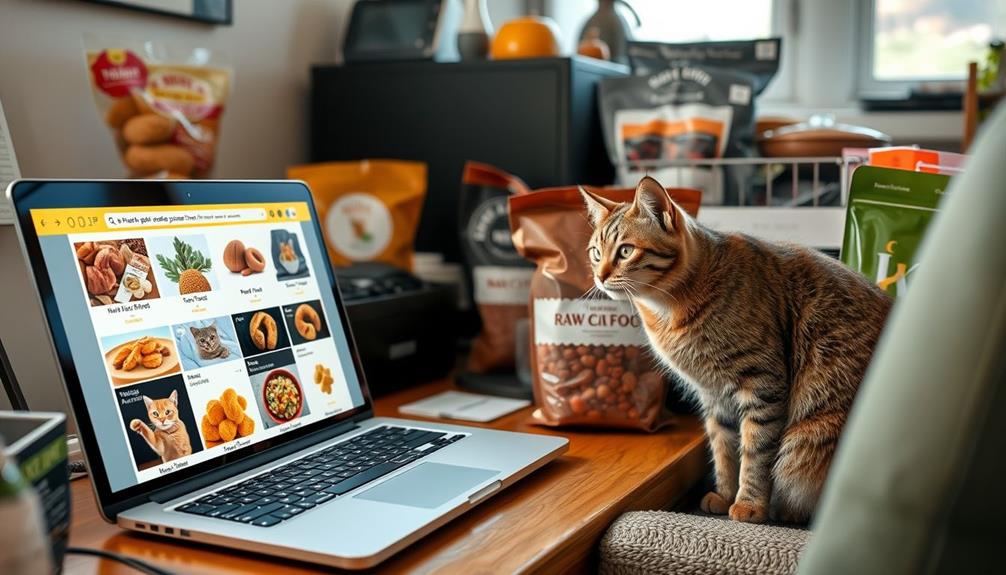
If you're looking for even more convenience, online retailers offer a fantastic selection of raw food for cats. Retailers like Petco provide a wide variety of raw cat food featuring different protein sources and dietary options to suit your feline's needs. You can easily browse through top brands such as Stella & Chewy's and Instinct directly on their websites, making your shopping experience both simple and efficient.
Additionally, for those considering diversification in pet nutrition, exploring investment strategies in precious metals can provide insightful parallels to maintaining a balanced diet for your cat.
Many online retailers also offer subscription options, which can save you money while ensuring you never run out of raw food. Regular deliveries mean you can keep your cat's diet consistent without the hassle of frequent shopping trips.
Plus, for those urgent situations, many retailers provide same-day delivery services for eligible products, so you can get raw food quickly when needed.
If you're looking to stock up, bulk purchasing options for frozen foods are commonly available as well. This way, you can secure your cat's preferred raw diets without worrying about running low.
Shopping online for raw food not only saves time but also gives you access to a broader selection tailored to your cat's health.
Local Farmers' Markets
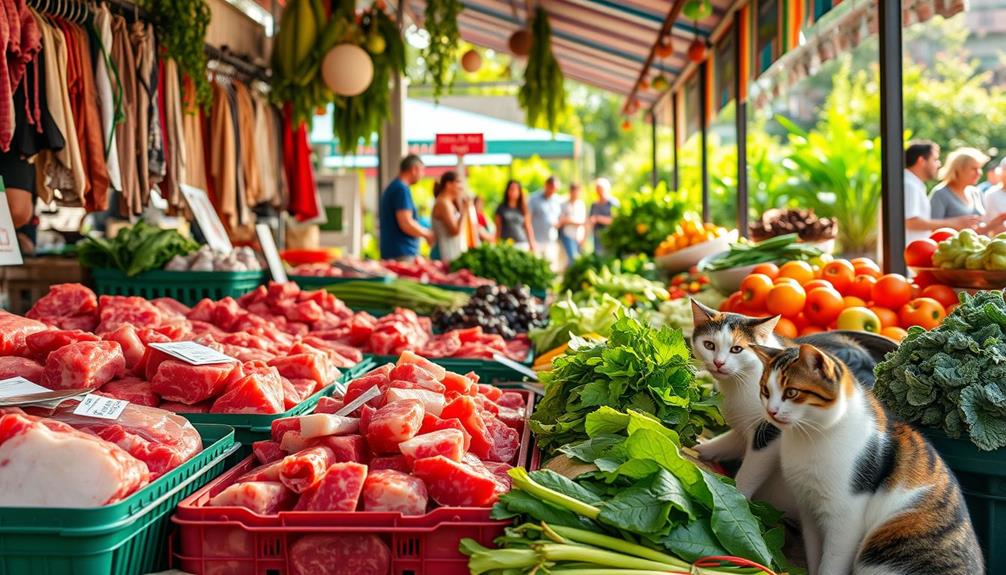
Local farmers' markets are a fantastic place to find fresh raw food for your cat, often featuring quality ingredients from local producers.
By shopping here, you not only support the local economy but also enjoy a variety of options that can enhance your cat's diet.
Additionally, you can take advantage of the opportunity to ask vendors about their products and their sourcing practices, which can help guarantee you're making informed choices about your cat's nutrition.
This aligns with the concept of budgeting for pet care, allowing you to plan for quality food while managing your finances.
Plus, you can ask vendors about their products, ensuring you know exactly what you're feeding your furry friend.
Freshness of Ingredients
When you prioritize freshness in your cat's diet, visiting farmers' markets can be a game changer. These markets often provide high-quality ingredients sourced directly from regional producers, ensuring peak freshness for your raw cat food.
Additionally, you can find unique offerings and community engagement similar to what's seen in the coffee culture, which emphasizes the importance of ethical sourcing and quality ethical sourcing practices.
Here's why you should consider shopping there:
- Quality Assurance: Ingredients are often harvested shortly before sale, meaning they can be fresher than those found in traditional retail stores.
- Ethical Sourcing: Many vendors prioritize sustainable and ethical farming practices, offering meats and organs free from antibiotics and hormones.
- Transparency: Shopping at farmers' markets lets you ask questions about the sourcing and handling of the ingredients, giving you peace of mind about what you're feeding your cat.
Supporting Local Economies
Purchasing raw cat food at farmers' markets greatly supports your community's local economy. When you buy raw pet food directly from local vendors, you're helping small-scale farmers and producers thrive rather than large corporations.
These markets often feature high-quality, locally sourced options, promoting sustainable agriculture practices that benefit both your cat and the environment. Additionally, many farmers are increasingly adopting energy efficiency practices that align with environmental sustainability, further enhancing the quality of their products.
At farmers' markets, you can find a variety of protein sources, like chicken, beef, and rabbit, ensuring your pet gets the freshest, natural options available. By choosing to shop locally, you foster relationships with these producers, gaining transparency about sourcing and ingredient quality—essential for maintaining your cat's health.
Moreover, purchasing raw food at farmers' markets reduces the carbon footprint associated with transporting food over long distances. This not only supports local economies but also contributes to environmental sustainability.
Variety of Options
Explore the diverse world of raw cat food at farmers' markets, where you'll find an array of fresh, high-quality ingredients sourced from nearby farms.
These markets often showcase vendors who specialize in raw foods specifically for cats, providing you with unique options that can enhance your pet's diet. Additionally, just like with healthy dog snacks, you can also find natural ingredients that promote overall health and wellness for your feline friend.
When you shop at farmers' markets, you can enjoy several benefits:
- Direct Interaction: Speak directly with producers to learn about the sourcing and nutritional benefits of their raw food offerings. This knowledge can help you make informed choices for your cat.
- Unique Proteins: Discover special protein options like venison or rabbit, which you won't typically find in commercial pet food. These alternatives can add variety and excitement to your cat's meals.
- Personalized Experience: Farmers' markets offer a more tailored shopping experience, allowing you to ask questions and find products that meet your pet's specific dietary needs.
Veterinary Clinics
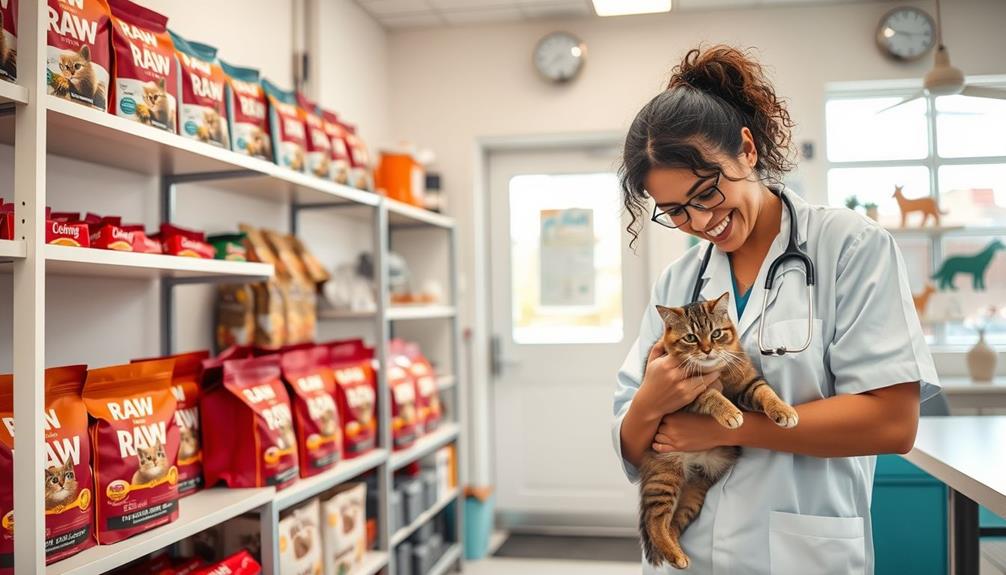
Veterinary clinics often provide a valuable resource for cat owners seeking raw food options. Many clinics offer specialized raw food brands that meet AAFCO nutritional standards, ensuring your feline gets a complete and balanced diet. You'll often find that veterinarians can recommend the best options tailored to your cat's specific health needs, age, and dietary restrictions.
Some clinics even have partnerships with raw food suppliers, allowing you to purchase fresh or frozen meals during your visit. This not only guarantees quality but also gives you peace of mind knowing you're choosing safe, reputable products for your cat.
Here's a quick overview of what to expect when buying raw food at veterinary clinics:
| Feature | Details |
|---|---|
| Quality Assurance | Products sourced from reputable suppliers |
| Personalized Advice | Tailored recommendations from veterinarians |
| Educational Resources | Workshops on raw feeding benefits |
| Variety of Options | Diverse brands available |
| Convenience | Purchase during your vet visit |
Subscription Services
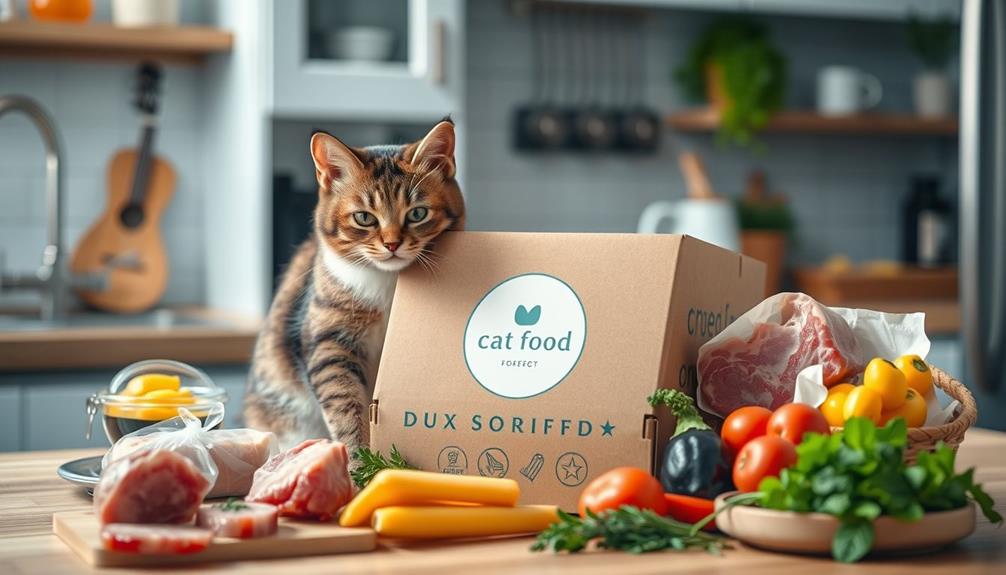
Subscription services make it easy for you to get raw food delivered right to your door, so you never have to worry about running out.
Many of these platforms have best websites to earn money online for pet owners looking to supplement their income while caring for their cats.
With flexible plans that let you choose monthly, bi-monthly, or tri-monthly deliveries, you can keep your cat's diet consistent.
Plus, these services often offer discounts for auto-renewals, making it a budget-friendly option for your furry friend.
Convenient Delivery Options
For busy pet owners, convenient delivery options like subscription services can make feeding your cat a breeze. With these services, you can guarantee your feline friend gets their complete meal without the hassle of frequent reordering.
Many websites, including advertising strategies, promote subscription services that simplify the process. Here are three key benefits of using a subscription service for raw cat food:
- Consistent Supply: Regular deliveries mean you'll never run out of food, keeping your pet's diet steady.
- Cost Savings: Many providers offer discounts, like 5% off with JustFoodForDogs, making this an economical choice.
- Flexibility: Brands such as Blue Ridge Beef allow you to choose monthly, bi-monthly, or tri-monthly plans to suit your needs.
Additionally, some companies, like Stella & Chewy's, even offer same-day delivery for those urgent feeding needs.
Plus, you can adjust or cancel your subscription anytime, adapting to your cat's changing dietary requirements. This flexibility guarantees that your furry companion always enjoys their complete meal without you stressing over when to reorder.
With these convenient delivery options, you can spend more time enjoying your pet's company and less time worrying about their food supply.
Flexible Subscription Plans
Many cat owners appreciate the flexibility that comes with subscription plans for raw cat food. These flexible subscription plans let you choose how often you want deliveries, whether that's monthly, bi-monthly, or tri-monthly. This guarantees your furry friend never runs out of their favorite meals and allows you to celebrate special occasions with heartfelt expressions of love.
By opting for a subscription, you often save money too. Discounts typically range from 5% to 10% off the regular price, making it an economical choice for pet owners. You can also pick from various meal types and sizes, including options tailored for kittens or those with special dietary needs.
One of the standout features of these subscription services is the ability to adjust quantities or even cancel orders at any time. This adaptability is perfect for accommodating your cat's changing needs or preferences.
Plus, many brands offer starter boxes for new subscribers, allowing you to sample different recipes before committing to a regular order.
With these flexible subscription plans, you can guarantee your cat gets the best raw food while enjoying the convenience and savings that come with it.
Bulk Purchasing Options
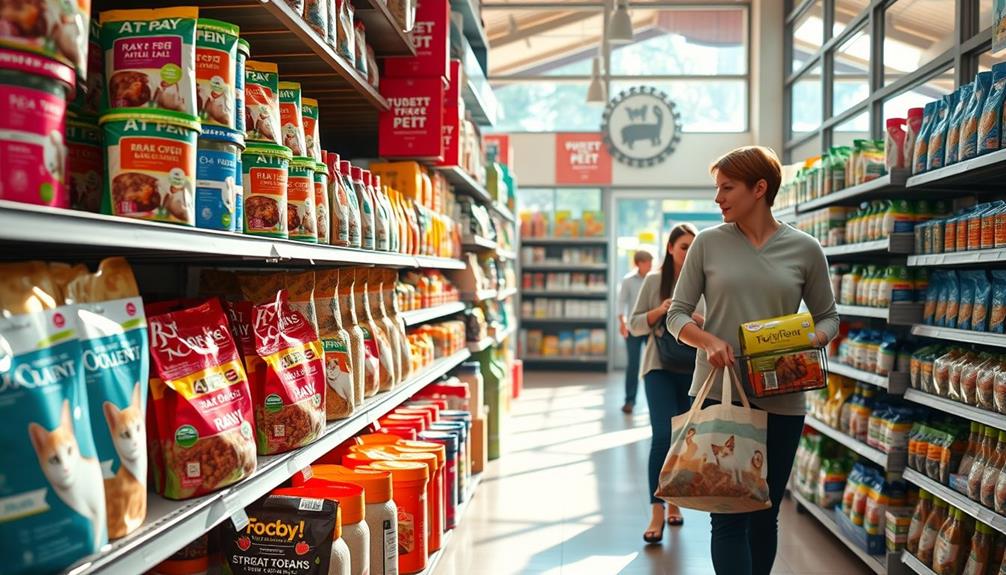
Bulk purchasing options for raw cat food can greatly cut down your overall costs while guaranteeing you always have a supply on hand. When you buy in bulk, you're not just saving money; you're also simplifying your life.
Additionally, it's important to guarantee that the brands you choose are reputable and well-reviewed, similar to how you'd research Gold IRA scams before making significant investments.
Here are three benefits of bulk purchasing options:
- Cost Savings: Brands like Stella & Chewy's offer products that range from $10.99 to $13.99 for individual packages, but buying larger quantities can lead to significant savings per meal.
- Convenient Storage: Frozen raw cat food can be purchased in bulk, which means you can stock up on 30lb cases from brands like Blue Ridge Beef. This allows for extended shelf life and easy meal planning.
- Regular Deliveries: Some retailers provide subscription services, guaranteeing you receive your bulk orders regularly without having to worry about running out.
Companies like JustFoodForDogs also facilitate easy online ordering for bulk purchases, giving you the chance to curate a variety of raw options for your feline friend.
Embrace these bulk purchasing options to enjoy both convenience and savings!
Frequently Asked Questions
What Is the Best Raw Cat Food?
The best raw cat food balances protein, bone, and organs, ideally in an 80-10-10 ratio. Look for options like Stella & Chewy's or Freshpet, ensuring they meet high-quality standards for your cat's health.
Can My Cat Eat Raw Meat From the Grocery Store?
Yes, your cat can eat raw meat from the grocery store, but make certain it's fresh and sourced from reputable suppliers. Always consult your vet to guarantee it meets your cat's nutritional needs safely.
Do Vets Recommend Raw Cat Food?
Many vets recommend raw cat food for its health benefits, like shiny coats and better digestion. However, they stress using high-quality ingredients and consulting them to guarantee your cat's specific needs are met safely.
What Raw Foods Are Safe for Cats?
When choosing raw foods for your cat, opt for high-quality meats like chicken or turkey. Make certain it includes the right nutritional ratio of meat, bone, and organs to support their health and digestion.
Conclusion
As you commence on the journey of providing raw food for your feline friend, remember to explore all your options. Whether you hit up local pet specialty stores or browse online retailers, you're bound to find the perfect meal for your cat. Embrace the joy of watching your kitty thrive, just like the good ol' days when pets were treated like family members. Your commitment to their health makes you a true ally in their well-being. Happy shopping!

